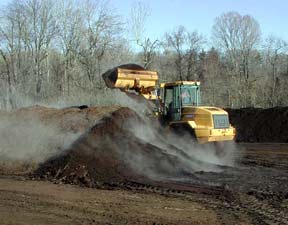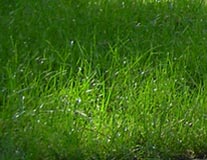 Compost is an enhanced soil conditioner created by the microbial decomposition of organic material. Manures, animal bedding, leaves, spoiled hay, grass clippings and food waste are common raw materials used by both backyard and farm compost producers.
Compost is an enhanced soil conditioner created by the microbial decomposition of organic material. Manures, animal bedding, leaves, spoiled hay, grass clippings and food waste are common raw materials used by both backyard and farm compost producers.
The process of active composting, where high carbon and high nitrogen materials are blended and frequently turned, dramatically accelerates the rate of decomposition of these materials. The microbes which feed on these materials multiply in vast numbers when proper moisture (50% to 70% moisture content) and ample oxygen are available. These aerobic (oxygen dependent) microbes include different communities of bacteria, actinomycetes (filamentous bacteria) and fungi which become active at different temperature thresholds.
Compost begins to heat up as microbes operating at lower temperatures become active. While feeding on the raw materials their numerous bodies give off a small amount of heat which slowly raises the temperature of the pile or windrow. Thermophilic (high temperature) bacteria, actinomycetes and fungi begin to operate when the compost pile or windrow reaches about 100 deg F.  Then the fun begins. These microbes are extremely active and increase to very large numbers with the right conditions: proper food, temperature, moisture and oxygen. Compost piles and windrows can easily reach 140 to 150 deg F when these critters are hard at work. Temperatures at or above 132 deg F for three days effectively kill weed seeds and pathogens. When compost is finished after many months and repeated turnings (which mix materials and add oxygen), the temperature has significantly decreased and the finished product is dark and rich looking, has an earthy smell and is loaded with many nutrients, as well as huge numbers of beneficial microorganisms. Major nutrients include nitrogen, phosphorous, potassium, magnesium, etc., the primary building blocks of pant growth. Micro nutrients include boron, manganese, zinc, copper and iron, which are needed in small doses for certain plants. Soils and plants thrive with the proper treatment of well-made compost.
Then the fun begins. These microbes are extremely active and increase to very large numbers with the right conditions: proper food, temperature, moisture and oxygen. Compost piles and windrows can easily reach 140 to 150 deg F when these critters are hard at work. Temperatures at or above 132 deg F for three days effectively kill weed seeds and pathogens. When compost is finished after many months and repeated turnings (which mix materials and add oxygen), the temperature has significantly decreased and the finished product is dark and rich looking, has an earthy smell and is loaded with many nutrients, as well as huge numbers of beneficial microorganisms. Major nutrients include nitrogen, phosphorous, potassium, magnesium, etc., the primary building blocks of pant growth. Micro nutrients include boron, manganese, zinc, copper and iron, which are needed in small doses for certain plants. Soils and plants thrive with the proper treatment of well-made compost.
BENEFITS OF USING COMPOST AS A SOIL AMENDMENT, TOP DRESSING OR MULCH:
![]()
![]() Soil organic matter over time is increased (desirable range 4% – 10%)
Soil organic matter over time is increased (desirable range 4% – 10%)
![]() Soil structure is improved resulting in improved aeration and plant root development
Soil structure is improved resulting in improved aeration and plant root development
![]()
![]() Plant pathogens are suppressed through the action of beneficial microorganisms
Plant pathogens are suppressed through the action of beneficial microorganisms
![]() Nitrogen is available in a slow release form reducing nutrient leaching
Nitrogen is available in a slow release form reducing nutrient leaching
![]()
![]() Drainage in clay soils is improved
Drainage in clay soils is improved
![]() Erosion and compaction are reduced through the formation of appropriately sized soil aggregates.
Erosion and compaction are reduced through the formation of appropriately sized soil aggregates.
![]()
![]() Essential micro nutrients such as boron, manganese, zinc, copper and iron are available for plant use
Essential micro nutrients such as boron, manganese, zinc, copper and iron are available for plant use
![]() Water-holding capacity of sandy soils is increased
Water-holding capacity of sandy soils is increased
RECOMENDED COMPOST USES
Some of the most common uses include:
![]() Fertilizer and soil conditioner for organic crop production
Fertilizer and soil conditioner for organic crop production
![]()
![]() Soil amendment for new lawn installations
Soil amendment for new lawn installations
![]() Ingredient in potting mix for perennials and shrubs
Ingredient in potting mix for perennials and shrubs
![]()
![]() Soil conditioner for tree and shrub plantings
Soil conditioner for tree and shrub plantings
![]() Nutritive mulch for perennial gardens
Nutritive mulch for perennial gardens
![]()
![]() Organic amendment for nursery crops and ornamental plant production
Organic amendment for nursery crops and ornamental plant production
![]() Ingredient in soilless mixes for bedding plants
Ingredient in soilless mixes for bedding plants
![]()
![]() Top dressing on lawns and athletic fields
Top dressing on lawns and athletic fields


